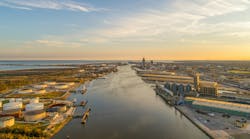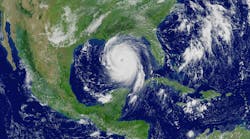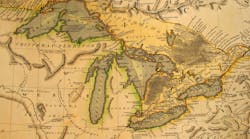Today, governments, environmental agencies and utilities are in various stages of maturity in collecting all types of water data. Much of this data is still gathered in silos across different departments at the organization level and across state and local government as well as industry organizations. Too often, data resides in on-premise hardware and interacts with legacy software that does not have the analytical capabilities to demonstrate real insights.
Without proper analysis, water professionals miss out on information that could be critical to completing essential tasks such as maintaining aging water infrastructure or managing storm water flows. Organizations need to find a way to break down silos, consolidate data and make sense of that data to achieve better, more sustainable water management.
Dealing with old technologies, unsupported infrastructure and monolithic architecture is a reality for many cities and agencies. These outdated systems not only leave organizations vulnerable to cybersecurity threats, they also create a management nightmare for IT teams. They require a lot of time and resources just to keep the lights on and are not appealing to the new generation of workers that are very much needed in the municipal water industry.
New Workforce is Well Positioned for Transformation & in Demand
Advances in digital technology have created an explosion in data in all aspects of our lives—water is no exception. According to the U.S. Bureau of Labor Statistics, almost 52% of workers in the water industry are over 45 years old, and 30% are due to retire in the next 10 years. An aging workforce makes succession planning urgent, and attracting and retaining employees is crucial. Utilities are competing with other industries for the same talent. Convincing new graduates and young professionals—Generation Z and Millennials—that exciting opportunities exist within a utility company or monitoring agency will require the industry to make fundamental changes.
The new generation of talent has expectations that challenge previously established norms of employee experience. By creatively addressing a common key challenge—digitization—utilities can position themselves to compete in the battle for talent. The workforce is also changing. Gone are the days of the 9-to-5 where people sit at their desks in the same office and share information by the water cooler. The pandemic accelerated a shift that had already begun, proving to employers and employees alike that remote work works.
Organizations that had lagged in the adoption of digital tools and processes were spurred into action, with one in three companies deciding to pursue digital transformation due to COVID-19. As a result, utilities have been thrust into digital collaboration and communication applications and processes to support remote workers, and as a result, many of the business silos are falling to the wayside in support of remote cross-functional collaboration.
Millennials and Generation Z are well-adapted to help their teams through digital transformation. These cohorts are digital natives, and they expect to be challenged and to perform work that interests them. This aligns well with a sector looking to implement and encourage the use of new technologies. By combining the best of all generations, it is possible to move towards collaborative and interdisciplinary ways of working and to speed up the change that has already begun.
Modern Data Management Tools Are Cloud Based
According to Bluefield Research, cloud computing offers greater resilience and redundancy for critical systems and data. Software-as-a-Service (SaaS) models reduce upfront CAPEX requirements and shift the responsibility for managing technology and delivering outcomes to suppliers.
Workforce transformation comes hand-in-hand with digital transformation. Having data intelligence in a secure cloud environment ensures subject matter experts do not take their knowledge with them when they leave or retire. With modern, best-in-class, hosted solutions, utilities can appeal to younger employees, and it is important to choose a partner that will help them on their journey. A good solutions provider will help a utility with deployment, training and support resources for a smooth transition to modern data management best practices.
The main business objectives of upgrading older systems include:
- Greater agility to respond to market needs;
- Improving application performance/responsiveness;
- Improving availability/disaster recovery; and
- Improving compliance/security.
Each of these objectives contributes to the efficient use of time and resources across an organization. The digitalization of water data management results in savings at both the operational and investment levels of the organization. By implementing modern solutions, a utility can create efficiencies, automate manual and repetitive tasks, and gain insights that enable them to move from being reactive to proactive.
Orlando Uses Storm Water Data to Reduce Liability
The City of Orlando Streets and Stormwater Division is responsible for maintaining and improving drainage facilities to prevent flooding and ensure all receiving water bodies meet state and federal water quality standards. It oversees upwards of 100 lakes within the city and approximately 147 drainage wells with 70 monitoring stations for lakes and waterways, and it monitors 23 rainfall stations collecting data by telemetry over a cellular network. The Streets and Stormwater Division keep 2 million people safe from flooding during heavy summer rainfalls and periodic tropical events.
The team implemented Aquarius to access data in real-time, run rating curves, calculate aggregates, and fill gaps in a matter of seconds. It is also capable of building more sophisticated multi-input time-series models. To broaden the sharing of data, in 2019 the city chose to make rainfall and stage information available to the public through hydrology.orlando.gov.
“In the past, evaluating the impact of these heavy rain events required multiple spreadsheets and hours of manual effort,” said Hensley Henry, Aquarius administrator, City of Orlando. “Now, with the push of a button, the software can create and retrieve customized intensities to evaluate isolated street flooding and protect the city against liability.”
Accurate reporting is only possible if you have visibility over all of your data. After all, you cannot manage or report on what you cannot see. Modern systems can help uncover data and connect the dots between disparate data sets to draw insights one may never have come to without technology. Good data creates more demand for good information. In other words, once one knows what they can know, they will want to know more, and so too will their stakeholders.
While cities around the world have made significant strides in digitizing transport and energy infrastructure, many have yet to connect their water supplies to their smart city systems. Digital technologies have real potential to transform the way communities predict, manage and harness water while improving visibility across the organization and sharing knowledge with citizens. Water intelligence systems increase network visibility, facilitate predictive maintenance, and ensure faster response times for events such as floods, operational failures, water quality concerns, pipe bursts and more.
Where to Start
Bluefield Research forecasts that the U.S. municipal water sector will spend more than $20 billion on software, data and analytics solutions over the next decade. Getting started on a project of this magnitude can be daunting, so it is best to start with a clear vision and strategy and then organize the four key pillars of data, people, process and technology. Below are some questions to get started.
Vision
- What is the desired future state?
Data
- What data do I have?
- Where is it stored?
- How do I turn it into insights?
- Do I need to connect to other data sources (internal or external)?
People
- What skills are in-house now?
- What skills will we need in the future?
- Is leadership on board? Do I have an executive sponsor?
- Is the team structured the right way?
- How do I plan for change management?
Process
- What are my core processes today?
- What should they look like in the future? What can be automated?
Technology
- Do I have the right tools for the right jobs?
- Will my current tech stack scale with my vision?
- What modern technologies can we use?
Change Management Is Difficult—Don’t Do It Alone
As organizations progress on their digital transformation journey, one of the main challenges they face is resistance to change. Cultural change within a water utility requires C-level executives to have a clear vision and internal advocates with a strong conviction to change the system. Incoming Millennials and Generation Z workers are technology natives and are great assets for digital transformation.
Getting people on board with the mission will be the most critical success factor. Technology partners can help organizations guide their change management strategies to ensure the success of any new technology projects. While every water organization is unique, many of the challenges are similar: legacy systems, data silos, lack of resources, etc.
About the author:
Erik Larsen is digital solutions expert for Aquatic Informatics. Larsen can be reached at [email protected].






